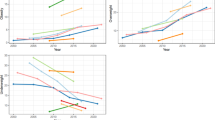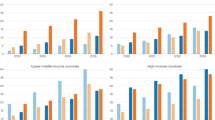Abstract
OBJECTIVE: To update the social distribution of women's obesity in the developing world and, in particular, to identify the specific level of economic development at which, if any, women's obesity in the developing world starts to fuel inequities in health.
DESIGN: Multilevel logistic regression analyses applied to anthropometric and socioeconomic data collected by nationally representative cross-sectional surveys conducted from 1992 to 2000 in 37 developing countries within a wide range of world regions and stages of economic development (gross national product (GNP) from US$190 to 4440 per capita).
SUBJECTS: In total, 148 579 nonpregnant women aged 20–49 y.
MEASUREMENTS: Body mass index to assess obesity status; quartiles of years of education to assess woman's socioeconomic status (SES), and GNP per capita to assess country's stage of economic development.
RESULTS: Belonging to the lower SES group confers strong protection against obesity in low-income economies, but it is a systematic risk factor for the disease in upper-middle income developing economies. A multilevel logistic model—including an interaction term between the country's GNP and each woman's SES—indicates that obesity starts to fuel health inequities in the developing world when the GNP reaches a value of about US$2500 per capita.
CONCLUSIONS: For most upper-middle income economies and part of the lower-middle income economies, obesity among adult women is already a relevant booster of health inequities and, in the absence of concerted national public actions to prevent obesity, economic growth will greatly expand the list of developing countries where this situation occurs.
This is a preview of subscription content, access via your institution
Access options
Subscribe to this journal
Receive 12 print issues and online access
$259.00 per year
only $21.58 per issue
Buy this article
- Purchase on SpringerLink
- Instant access to full article PDF
Prices may be subject to local taxes which are calculated during checkout


Similar content being viewed by others
References
World Health Organization. Obesity: preventing and managing the global epidemic. WHO: Geneva; 2000. WHO Technical Report Series No. 894.
Sobal J, Stunkard AJ . Socioeconomic status and obesity: a review of the literature. Psychol Bull 1989; 105: 260–275.
Berrios CX, Jadue HL, Zenteno AJ, Ross AMI, Rodrigues HP . Prevalencias de factores de riesgo de enfermedades crónicas. Estudio en la población general de la Región Metropolitana. Rev Med Chile 1990; 118: 597–604.
Sichieri R, Coitinho DC, Leão MM, Recine E, Everhart JE . High temporal, geographical and income variation in body mass index among adults in Brazil. Am J Public Health 1994; 84: 793–798.
Monteiro CA, Mondini L, Souza ALM, Popkin BM . The nutrition transition in Brazil. Eur J Clin Nutr 1995; 4: 105–113.
Grol MEC, Eimers JM, Alberts JF et al. Alarmingly high prevalence of obesity in Curaçao: data from an interview survey stratified for socioeconomic status. Int J Obes Relat Metab Disord 1997; 21: 1002–1009.
Monteiro CA, Conde WL . A tendência secular da obesidade segundo estratos sociais: Nordeste e Sudeste do Brasil, 1975–1989–1997. Arq Bras Endocrinol Metab 1999; 43: 186–194.
Monteiro CA, Benicio MHD'A, Conde WL, Popkin BM . Shifting obesity trends in Brazil. Eur J Clin Nutr 2000; 54: 342–346.
Martorell R, Khan LK, Hughes ML, Grummer-Strawn LM . Obesity in women from developing countries. Eur J Clin Nutr 2000; 54: 247–252.
Popkin BM, Ge K, Zhai F, Guo X, Ma H, Zohoori N . The nutrition transition in China: a cross-sectional analysis. Eur J Clin Nutr 1993; 47: 333–346.
Rivera JA, Barquera S, Campirano F, Campos I, Safdie M, Tovar V . Epidemiological and nutritional transition in Mexico: rapid increase of non-communicable chronic diseases and obesity. Public Health Nutr 2002; 5: 113–122.
Thang NM, Popkin BM . Patterns of food consumption in Vietnam: effects on socioeconomic groups during an era of economic growth. Eur J Clin Nutr, (in press).
Boerma JT, Sommerfelt AE . Demographic and Health Surveys (DHS): contributions and limitations. World Health Statistics Qtly 1993; 46: 222–226.
Lohman TG, Roche AF, Martorell R . Anthropometric standardization reference manual. Human Kinetics Books: Champain, IL; 1988.
Ahmad OB, Boschi-Pinto C, Lopez AD, Murray CJL, Lozano R, Inoue M . Age standardization of rates: a new WHO standard. World Health Organization: Geneva; 1999. (GPE Discussion Paper Series, No. 31).
Szklo M, Javier Nieto F . Epidemiology: beyond the basics. Aspen Publihers Inc.: Gaithersburg, MD; 2000.
Greenland S . Principles of multilevel modelling. Int J Epidemiol 2000; 29: 158–167.
Van Erkel AR, Pattynama PMT . Receiver operating characteristic (ROC) analysis: basic principles and applications in radiology. Eur J Radiol 1998; 27: 88–94.
Stata Corporation. Stata Statistical Software: Release 5.0. Stata Corportation: College Station, TX; 1997.
Yang M, Rasbash J, Goldstein H, Barbosa M . MLwiN Macros for advanced multilevel modelling. Institute of Education: London; 1999.
Monteiro CA, Conde WL, Popkin BM . Is obesity replacing to undernutrition? Evidence from different social classes in Brazil. Public Health Nutr 2002; 5: 105–112.
Stunkard AJ . Factors in obesity: current views. In: Peña M, Bacallao J (eds) Obesity and poverty: a new public health challenge. Pan American Health Organization: Washington, DC; 2000. pp 23–28.
Liberatos P, Link BG, Kesley JL . The measurement of social class in epidemiology. Epidemiol Rev 1988; 10: 87–121.
World Health Organization. Diet, nutrition and the prevention of chronic diseases. WHO: Geneva; 2003. WHO Technical Report Series, No. 916.
Acknowledgements
We thank several colleagues who shared data with us, including Dr Juan Rivera (Mexico), Dr Debbie Bradshaw (South Africa) and the data coordinator of DHS. We also thank Aluísio JD Barros, Professor of Biostatistics at the University of Pelotas, Brazil, for his advice on the use of multilevel models. We thank the NIH (R01-HD30880 and R01-HD38700) and the Fogarty International Center, NIH for financial support for the analysis. We also wish to thank Ms Regina Rodrigues and Ms Frances L Dancy for administrative assistance, Mr Tom Swasey for graphics support, and Mr Bill Shapbell for editing assistant.
Author information
Authors and Affiliations
Corresponding author
Rights and permissions
About this article
Cite this article
Monteiro, C., Conde, W., Lu, B. et al. Obesity and inequities in health in the developing world. Int J Obes 28, 1181–1186 (2004). https://doi.org/10.1038/sj.ijo.0802716
Received:
Revised:
Accepted:
Published:
Issue Date:
DOI: https://doi.org/10.1038/sj.ijo.0802716



